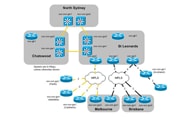Cisco Unified Video Advantage brings video telephony to Cisco Unified IP phones.
Cisco® Unified Video Advantage brings video telephony to Cisco Unified IP phones, enabling users to add video to their communications experience. This video telephony solution is based on Cisco Unified CallManager and is comprised of the Cisco Unified Video Advantage software application, Cisco VT Camera, and a standard Cisco Unified IP phone. With a Cisco VT Camera attached to a PC colocated with a Cisco Unified IP phone, a user can place and receive video calls from the IP phone. Users can make calls using the familiar phone interface, and calls are enhanced with video without requiring any extra button-pushing.
- Whenever Cisco SystemsŪ considers introducing a new internal service or technology, Cisco IT must understand the user impact and benefits in order to justify the costs associated with the new capability. From a technical perspective, Cisco IT must ensure that new technology will not interfere with the delivery of mission-critical services, and that it will integrate with the company's existing infrastructure. The Cisco Unified Video Advantage pilot was initiated with the following business goals:
- Demonstrate and promote Cisco video telephony innovation by helping Cisco become its own best customer.
- Develop a scalable, supportable, easy-to-use architecture that can be used by other Cisco customers and that validates Cisco's virtually networked voice and video strategy.
- Integrate the Cisco Unified Video Advantage solution with voice and video conferencing technologies currently available to Cisco employees.
- Provide the solution to all Cisco sites that have adequate infrastructure resources and adequate end-user demand.
- To understand the impact Cisco Unified Video Advantage would have on the infrastructure, a pilot was planned for early 2005. Four major goals were identified to drive the gathering of metrics and fully evaluate this new enterprise service:
- Cisco Unified CallManager— Evaluate Cisco Unified Video Advantage's impact on the reliability and stability of CallManager clusters. Measure the CPU load imposed, as well as the increase in utilization of virtual memory.
- Network—Determine the additional bandwidth required for the video service, and measure the incidence of insufficient bandwidth during typical use. Validate quality of service (QoS) policies and test functions to provide sufficient priority for audio and video calls.
- Required support resources—Validate support processes, and determine any additional support requirements. Monitor common support requests, evaluate self-install feasibility, and test the Web-based training for the future companywide rollout.
- User benefits—Survey pilot users to determine the typical usage patterns, enhanced communications, productivity improvements, and other tangible benefits from the deployment.
Approximately 750 Cisco employees were registered as pilot users. These employees were located in 46 different Cisco locations across the globe. Sites and users were chosen for a variety of reasons. Selected users were part of cross-functional organizations or virtual teams that required a significant amount of intersite meetings conducted by video or audio conference. These included engineers, executives, technical support employees, and sales managers. Each site had to be able to participate in the full production deployment. These sites usually consisted of campuses, with multiple buildings.
The Cisco network topology is complex, comprised of multiple hub-and-spoke sites that are linked together in a partial mesh topology. Several Cisco Unified CallManager clusters route voice calls across this network. While effective, this configuration made it challenging to capture accurate network and CallManager metrics required for the pilot. To overcome these challenges, the Australia/New Zealand (ANZ) region was added to the list of sites to participate in the pilot. This region, consisting of multiple sites, is supported by a single CallManager cluster and was able to provide accurate and accessible usage reporting information. In addition, all of the ANZ sites are connected via a Multiprotocol Label Switching (MPLS) VPN topology, where all sites are one network hop away from each other. This provides an accurate environment for measuring network bandwidth usage-all site traffic traverses a single gateway (or router) interface (Figure 1). Finally, the ANZ sites have much smaller WAN connections (2-10 MB) than the rest of the participating locations. These smaller connections make it easier to study the potential WAN bandwidth and impact of QoS on video telephony communications.
The success of the pilot was due in part to effective postpilot communications. User feedback was gathered using Web-based surveys. Combined with other measurements taken during the pilot, the overall feedback and lessons learned were channeled back to Cisco product marketing, engineering, and sales and marketing teams.
The data collected by the project team was focused on meeting the goals defined prior to the initiation of the pilot:
- Cisco Unified CallManager impact—The CallManager cluster supporting the ANZ sites was used to measure this impact. CPU load and virtual memory utilization were examined, and video calls placed or received were counted and captured in the CallManager call detail records (CDRs). By comparing measurements before and during the pilot, the project team determined that Cisco Unified Video Advantage calls did not negatively impact the existing CallManager cluster.
Rob Gates,
Project Manager, Cisco IT
- Network impact—A network analysis tool, NetQoS, was used to measure the Cisco Unified Video Advantage deployment's impact on the underlying network. Several CallManager counters were tracked during this measurement, including video calls completed, incidences of "video out of resources," and available video bandwidth. These measurements determined that the network was not a limiting factor for the 750-user pilot. In addition, the number of simultaneous calls was higher than the number of calls rejected due to insufficient bandwidth. Put another way, calls would complete with video more frequently than without. The pilot survey indicated that the limiting factor was likely due to the limited number of people with cameras participating in the pilot.
- Support—The pilot evaluated the impact on support resources and the effectiveness of user training modules. It was determined that the current support resources, with the addition of one Cisco Global Technical Response Center (GTRC) technical support analyst, would be able to successfully handle the additional cases generated by a production deployment of Cisco Unified Video Advantage. The majority of support requests were categorized as installation and setup issues, and centered around getting users' IP phones enabled so they could participate in the pilot. Additional installation and setup procedures were simplified for the production rollout, including the creation of a quick-start guide and onsite tutorial events to clarify installation procedures and minimize support requests.
- User benefits—To evaluate the potential productivity benefits of adding video to audio calls, a postpilot survey was sent to 750 pilot participants, and 136 (17 percent) participants responded (Figures 2 and 3). The questions focused on ease of use, increase in productivity, and rate of adoption. According to the survey results, the Cisco Unified Video Advantage application was easy to install and operate. The adoption survey questions and additional anecdotal feedback indicate that, when the full production rollout is complete and all employees have Cisco Unified Video Advantage, the usage rate will dramatically increase and productivity gains will be easier to quantify.
The Cisco Unified Video Advantage pilot project was deemed a success, with measurable goals and satisfied users. The lessons learned include:
- Phones should be "blanket-enabled" at a given site (not enabled one by one) to reduce the support burden.
- Pilot users would like to be able to place multipoint calls.
- More than 80 percent of the support requests were resolved by level 1 and level 2 support staff.
- Productivity improvements were difficult to quantify due to the limited number of video callers, but pilot users consistently expressed the opinion that the solution would provide more productivity improvements when it is more broadly deployed.
- Cisco Unified Video Advantage deployment has little impact on production CallManager.
- The network was not the major bottleneck in smaller deployments like ANZ, but technology adoption seems to be a bigger barrier based on the restricted number of pilot participants.
"At Cisco, we try to be our own best customer," says Rob Gates, the Cisco IT Project Manager for the Cisco Unified Video Advantage pilot. "Our business environment changes rapidly and the challenges we face are typical of any large enterprise. With a new technology like video telephony, a deployment must carefully evaluate the potential gains against any impact on current support resources and infrastructure."
The planning and implementation of a broader rollout of Cisco Unified Video Advantage to all Cisco employees located at Tier 1 sites began immediately after the pilot project was completed. It is expected that an additional 30,000 cameras will be deployed by the fourth quarter of fiscal year 2006.


